Impacts of Hurricane Michael on Watershed Hydrology: A Case Study in the Southeastern United States
Abstract
:1. Introduction
2. Materials and Methods
2.1. Study Area
2.2. Vegetation Condition
2.3. Climate Data
2.4. Methods for Detecting the Impact of Forest Disturbance on Flow
2.4.1. Daily and Flow Duration Curves
2.4.2. Double Mass Curve (DMC)
2.4.3. Water Supply Stress Index (WaSSI) Hydrologic Model
3. Results
3.1. Forest Disturbance
3.2. Precipitation and Streamflow Distribution
3.3. Streamflow Deviation Due to Hurricane Michael as Determined by the Double Mass Curve (DMC) Method
3.4. WaSSI Model Validation and Application
4. Discussion
5. Conclusions
Author Contributions
Funding
Conflicts of Interest
References
- Amatya, D.M.; Trettin, C.C. Long-Term Ecohydrologic Monitoring: A Case Study from the Santee Experimental Forest, South Carolina. J. South Carol. Water Resour. 2020, 6, 46–55. [Google Scholar] [CrossRef]
- Bender, M.A.; Knutson, T.R.; Tuleya, R.E.; Sirutis, J.J.; Vecchi, G.A.; Garner, S.T.; Held, I.M. Modeled Impact of Anthropogenic Warming on the Frequency of Intense Atlantic Hurricanes. Science 2010, 327, 454–458. [Google Scholar] [CrossRef] [PubMed] [Green Version]
- Chen, X.; Kumar, M.; McGlynn, B.L. Variations in Streamflow Response to Large Hurricane-Season Storms in a Southeastern US Watershed. J. Hydrometeorol. 2015, 16, 55–69. [Google Scholar] [CrossRef]
- Dai, Z.; Amatya, D.M.; Sun, G.; Trettin, C.C.; Li, C.; Li, H. Climate Variability and Its Impact on Forest Hydrology on South Carolina Coastal Plain, U.S.A. Atmosphere 2011, 2, 330–357. [Google Scholar] [CrossRef] [Green Version]
- Mallin, M.A.; Corbett, C.A. How hurricane attributes determine the extent of environmental effects: Multiple hurricanes and different coastal systems. Estuaries Coasts 2006, 29, 1046–1061. [Google Scholar] [CrossRef]
- Miller, P.W.; Kumar, A.; Mote, T.L.; Moraes, F.D.S.; Mishra, D.R. Persistent Hydrological Consequences of Hurricane Maria in Puerto Rico. Geophys. Res. Lett. 2019, 46, 1413–1422. [Google Scholar] [CrossRef] [Green Version]
- McNulty, S.G. Hurricane impacts on US forest carbon sequestration. Environ. Pollut. 2002, 116, S17–S24. [Google Scholar] [CrossRef]
- Chapman, E.L.; Chambers, J.Q.; Ribbeck, K.F.; Baker, D.B.; Tobler, M.A.; Zeng, H.; White, D.A. Hurricane Katrina impacts on forest trees of Louisiana’s Pearl River basin. For. Ecol. Manag. 2008, 256, 883–889. [Google Scholar] [CrossRef]
- Sun, G.; Zuo, C.; Liu, S.; Liu, M.; McNulty, S.G.; Vose, J.M. Watershed Evapotranspiration Increased due to Changes in Vegetation Composition and Structure Under a Subtropical Climate1. JAWRA J. Am. Water Resour. Assoc. 2008, 44, 1164–1175. [Google Scholar] [CrossRef] [Green Version]
- Yih, K.; Boucher, D.H.; Vandermeer, J.H.; Zamora, N. Recovery of the Rain Forest of Southeastern Nicaragua After Destruction by Hurrican Joan. Biotropica 1991, 23, 106. [Google Scholar] [CrossRef]
- Steyer, G. Landscape Analysis of Vegetation Change in Coastal Louisiana following Hurricanes Katrina and Rita. Ph.D. Thesis, Louisiana State University, Baton Rouge, LA, USA, 2008. [Google Scholar]
- Neubauer, S.C. Ecosystem Responses of a Tidal Freshwater Marsh Experiencing Saltwater Intrusion and Altered Hydrology. Estuaries Coasts 2011, 36, 491–507. [Google Scholar] [CrossRef]
- Amatya, D.M.; Williams, T.M.; Nettles, J.E.; Skaggs, R.W.; Trettin, C.C. Comparison of Hydrology of Two Atlantic Coastal Plain Forests. Trans. ASABE 2019, 62, 1509–1529. [Google Scholar] [CrossRef]
- Bosch, D.D.; Sullivan, D.G.; Sheridan, J.M. Hydrologic impacts of land-use changes in coastal plain watersheds. Trans. ASABE 2006, 49, 423–432. [Google Scholar] [CrossRef]
- Sun, G.; Lu, J.; Gartner, D.L.; Miwa, M.; Trettin, C.C. Water budgets of two forested watersheds in South Carolina. In Proceedings of the Awra’s Annual Water Resources Conference, Miami, FL, USA, 6 November 2000. [Google Scholar]
- Sun, G.; McNulty, S.G.; Amatya, D.M.; Skaggs, R.W.; Swift, L.W.; Shepard, J.P.; Riekerk, H. A comparison of the watershed hydrology of coastal forested wetlands and the mountainous uplands in the Southern US. J. Hydrol. 2002, 263, 92–104. [Google Scholar] [CrossRef]
- Shelby, J.D.; Chescheir, G.M.; Skaggs, R.W.; Amatya, D.M. Hydrologic and water-quality response of forested and agricultural lands during the 1999 extreme weather conditions in eastern north carolina. Trans. ASAE 2005, 48, 2179–2188. [Google Scholar] [CrossRef] [Green Version]
- Swank, W.T.; Swift, L.W.; Douglass, J.E. Streamflow Changes Associated with Forest Cutting, Species Conversions, and Natural Disturbances. For. Hydrol. Ecol. Coweeta 1988, 66, 297–312. [Google Scholar] [CrossRef]
- Dai, Z.; Trettin, C.C.; Amatya, D.M. Effects of Climate Variability on Forest Hydrology and Carbon Sequestration on the Santee Experimental Forest in Coastal South Carolina; Gen. Tech. Rep. SRS-GTR-172; USDA-Forest Service, Southern Research Station: Asheville, NC, USA, 2013; p. 32.
- Sun, G.; Noormets, A.; Gavazzi, M.J.; McNulty, S.G.; Chen, J.; Domec, J.-C.; King, J.S.; Amatya, D.M.; Skaggs, R.W. Energy and water balance of two contrasting loblolly pine plantations on the lower coastal plain of North Carolina, U.S.A. For. Ecol. Manag. 2010, 259, 1299–1310. [Google Scholar] [CrossRef]
- Jayakaran, A.D.; Williams, T.M.; Ssegane, H.; Amatya, D.M.; Song, B.; Trettin, C.C. Hurricane impacts on a pair of coastal forested watersheds: Implications of selective hurricane damage to forest structure and streamflow dynamics. Hydrol. Earth Syst. Sci. 2014, 18, 1151–1164. [Google Scholar] [CrossRef] [Green Version]
- Amatya, D.M.; Miwa, M.; Harrison, C.A.; Trettin, C.C.; Sun, G. Hydrology and water quality of two first order forested watersheds in Coastal South Carolina (Paper Number 062182). In Proceedings of the ASABE Annual International Meeting, Portland, OR, USA, 9–12 July 2006. [Google Scholar]
- Kenney, G.; Staudhammer, C.L.; Wiesner, S.; Brantley, S.T.; Bigelow, S.W.; Starr, G. Hurricane Michael Altered the Structure and Function of Longleaf Pine Woodlands. J. Geophys. Res. Biogeosci. 2021, 126, e2021JG006452. [Google Scholar] [CrossRef]
- Beven, J., II; Berg, R.; Hagen, A. National Hurricane Center Tropical Cyclone Report: Hurricane Michael (AL142018). 2019. Available online: https://www.nhc.noaa.gov/data/tcr/AL142018_Michael.pdf (accessed on 2 February 2022).
- Florida Forest Service. Hurricane Michael: Initial Value Estimate of Altered, Damaged, or Destroyed Timber in Florida; Florida Forest Service: Tallahassee, FL, USA, 2018.
- Bates, C.; McClure, M. Timber Impact Assessment: Hurricane Michael. Forest Health Management Group, Georgia Forestry Commission. Available online: https://gatrees.org/wp-content/uploads/2020/01/Hurricane-MichaelTimber-Impact-Assessment-Georgia-October-10-11-2018-2.pdf (accessed on 3 March 2022).
- Alabama Forestry Commission. Storm Damage Assessment Report: Hurricane Michael. In Proceedings of the Alabama Forestry Commission, Montgomery, AL, USA, 10 October 2018. [Google Scholar]
- Castagno, K.A.; Tomiczek, T.; Shepard, C.C.; Beck, M.W.; Bowden, A.A.; O’Donnell, K.; Scyphers, S.B. Resistance, resilience, and recovery of salt marshes in the Florida Panhandle following Hurricane Michael. Sci. Rep. 2021, 11, 20381. [Google Scholar] [CrossRef]
- Zampieri, N.E.; Pau, S.; Okamoto, D.K. The impact of Hurricane Michael on longleaf pine habitats in Florida. Sci. Rep. 2020, 10, 8483. [Google Scholar] [CrossRef] [PubMed]
- D’Sa, E.J.; Joshi, I.D.; Liu, B.; Ko, D.S.; Osburn, C.L.; Bianchi, T.S. Biogeochemical Response of Apalachicola Bay and the Shelf Waters to Hurricane Michael Using Ocean Color Semi-Analytic/Inversion and Hydrodynamic Models. Front. Mar. Sci. 2019, 6, 523. [Google Scholar] [CrossRef]
- Wang, Y. Detecting Vegetation Recovery Patterns After Hurricanes in South Florida Using NDVI Time Series. Ph.D. Thesis, University of Miami, Coral Gables, FL, USA, 2012. Available online: https://scholarship.miami.edu/esploro/outputs/graduate/Detecting-Vegetation-Recovery-Patterns-After-Hurricanes/991031447547302976 (accessed on 2 February 2022).
- Karels, J. Introduction to Forestry in Florida; Florida Forest Service: Tallahassee, FL, USA, 2012.
- Zhang, M.; Wei, X.; Sun, P.; Liu, S. The effect of forest harvesting and climatic variability on runoff in a large watershed: The case study in the Upper Minjiang River of Yangtze River basin. J. Hydrol. 2012, 464, 1–11. [Google Scholar] [CrossRef]
- Caldwell, P.V.; Sun, G.; McNulty, S.G.; Cohen, E.C.; Moore Myers, J.A. Modeling Impacts of Environmental Change on Ecosystem Services across the Conterminous United States. In Proceedings of the Observing, Studying, and Managing for Change-Proceedings of the Fourth Interagency Conference on Research in the Watersheds: US Geological Survey Scientific Investigations Report 2011-5169, Fairbanks, AK, USA, 26–30 September 2011; Medley, C.N., Patterson, G., Parker, M.J., Eds.; p. 202. Available online: http://pubs.usgs.gov/sir/2011/5169/ (accessed on 18 December 2021).
- Caldwell, P.V.; Sun, G.; McNulty, S.G.; Cohen, E.C.; Moore Myers, J.A. Impacts of impervious cover, water withdrawals, and climate change on river flows in the conterminous US. Hydrol. Earth Syst. Sci. 2012, 16, 2839–2857. [Google Scholar] [CrossRef] [Green Version]
- Sun, G.; Caldwell, P.; Noormets, A.; McNulty, S.G.; Cohen, E.; Moore Myers, J.; Domec, J.-C.; Treasure, E.; Mu, Q.; Xiao, J.; et al. Upscaling key ecosystem functions across the conterminous United States by a water-centric ecosystem model. J. Geophys. Res. 2011, 116. [Google Scholar] [CrossRef]
- Caldwell, P.V.; Kennen, J.G.; Sun, G.; Kiang, J.E.; Butcher, J.B.; Eddy, M.C.; Hay, L.E.; LaFontaine, J.H.; Hain, E.F.; Nelson, S.A.C.; et al. A comparison of hydrologic models for ecological flows and water availability. Ecohydrology 2015, 8, 1525–1546. [Google Scholar] [CrossRef]
- Caldwell, P.V.; Kennen, J.G.; Hain, E.F.; Nelson, S.A.; Sun, G.; McNulty, S.G. Hydrologic Modeling for Flow-Ecology Science in the Southeastern United States and Puerto Rico; e-Gen. Tech. Rep. SRS-246; US Department of Agriculture Forest Service, Southern Research Station: Asheville, NC, USA, 2020; p. 77. Available online: https://www.fdacs.gov/content/download/82204/file/hurricanemichaelinitialtimberdamageestimate_lite.pdf (accessed on 14 March 2022).
- Li, C.; Sun, G.; Caldwell, P.V.; Cohen, E.; Fang, Y.; Zhang, Y.; Oudin, L.; Sanchez, G.M.; Meentemeyer, R.K. Impacts of Urbanization on Watershed Water Balances Across the Conterminous United States. Water Resour. Res. 2020, 56. [Google Scholar] [CrossRef]
- Schwalm, C.R.; Huntzinger, D.N.; Cook, R.B.; Wei, Y.; Baker, I.T.; Neilson, R.P.; Poulter, B.; Caldwell, P.; Sun, G.; Tian, H.Q.; et al. How well do terrestrial biosphere models simulate coarse-scale runoff in the contiguous United States? Ecol. Model. 2015, 303, 87–96. [Google Scholar] [CrossRef] [Green Version]
- Burnash, R.J.C. The NWS river forecast system—Catchment modelling. In Computer Models of Watershed Hydrology; Singh, V.P., Ed.; Water Resources Publications: Littleton, CO, USA, 1995; pp. 311–366. [Google Scholar]
- Burnash, R.J.C.; Ferral, R.L.; McGuire, R.A. A Generalized Streamflow Simulation System: Conceptual Modeling for Digital Computers; Joint Federal-State River Forecast, US Department of Commerce, National Weather Service, and State of California, Department of Water Resources: Sacramento, CA, USA, 1973. [Google Scholar]
- Koren, V.; Smith, M.; Duan, Q. Use of a priori parameter estimates in the derivation of spatially. In Calibration Watershed Model; American Geophysical Union: Washington, DC, USA, 2003; p. 239. [Google Scholar]
- Hamon, W.R. Computation of direct runoff amounts from storm rainfall. Int. Assoc. Sci. Hydrol. Publ. 1963, 63, 52–62. [Google Scholar]
- Gupta, H.V.; Kling, H.; Yilmaz, K.K.; Martinez, G.F. Decomposition of the mean squared error and NSE performance criteria: Implications for improving hydrological modelling. J. Hydrol. 2009, 377, 80–91. [Google Scholar] [CrossRef] [Green Version]
- Brown, A.E.; Zhang, L.; McMahon, T.A.; Western, A.W.; Vertessy, R.A. A review of paired catchment studies for determining changes in water yield resulting from alterations in vegetation. J. Hydrol. 2005, 310, 28–61. [Google Scholar] [CrossRef]
- Zhang, M.; Liu, N.; Harper, R.; Li, Q.; Liu, K.; Wei, X.; Ning, D.; Hou, Y.; Liu, S. A global review on hydrological responses to forest change across multiple spatial scales: Importance of scale, climate, forest type and hydrological regime. J. Hydrol. 2017, 546, 44–59. [Google Scholar] [CrossRef] [Green Version]
- Grace, J.M., III. Forest operations and water quality in the south. Trans. ASAE 2005, 48, 871–880. [Google Scholar] [CrossRef] [Green Version]
- Sun, J.; Wei, X.; Zhou, Y.; Chan, C.; Diao, J. Hurricanes Substantially Reduce the Nutrients in Tropical Forested Watersheds in Puerto Rico. Forests 2022, 13, 71. [Google Scholar] [CrossRef]
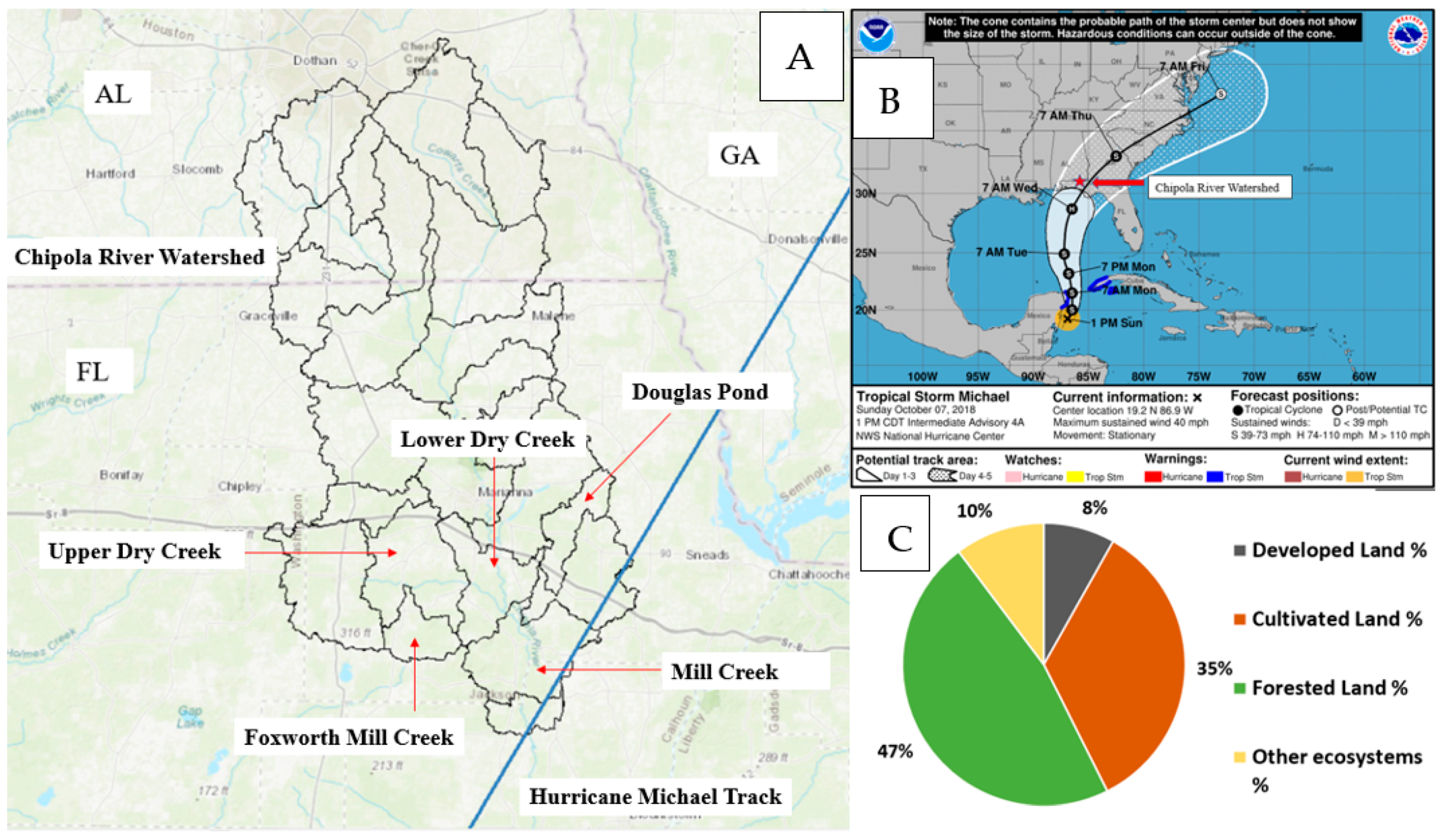

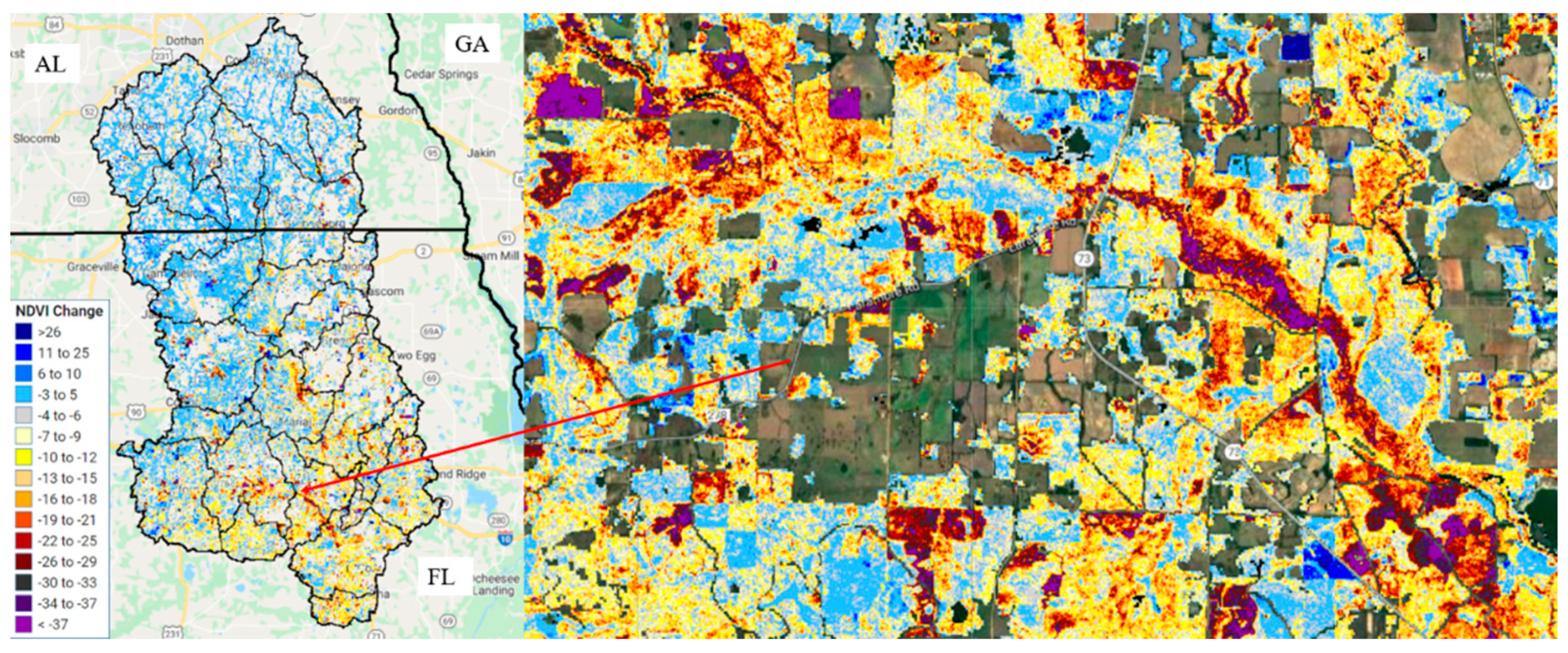
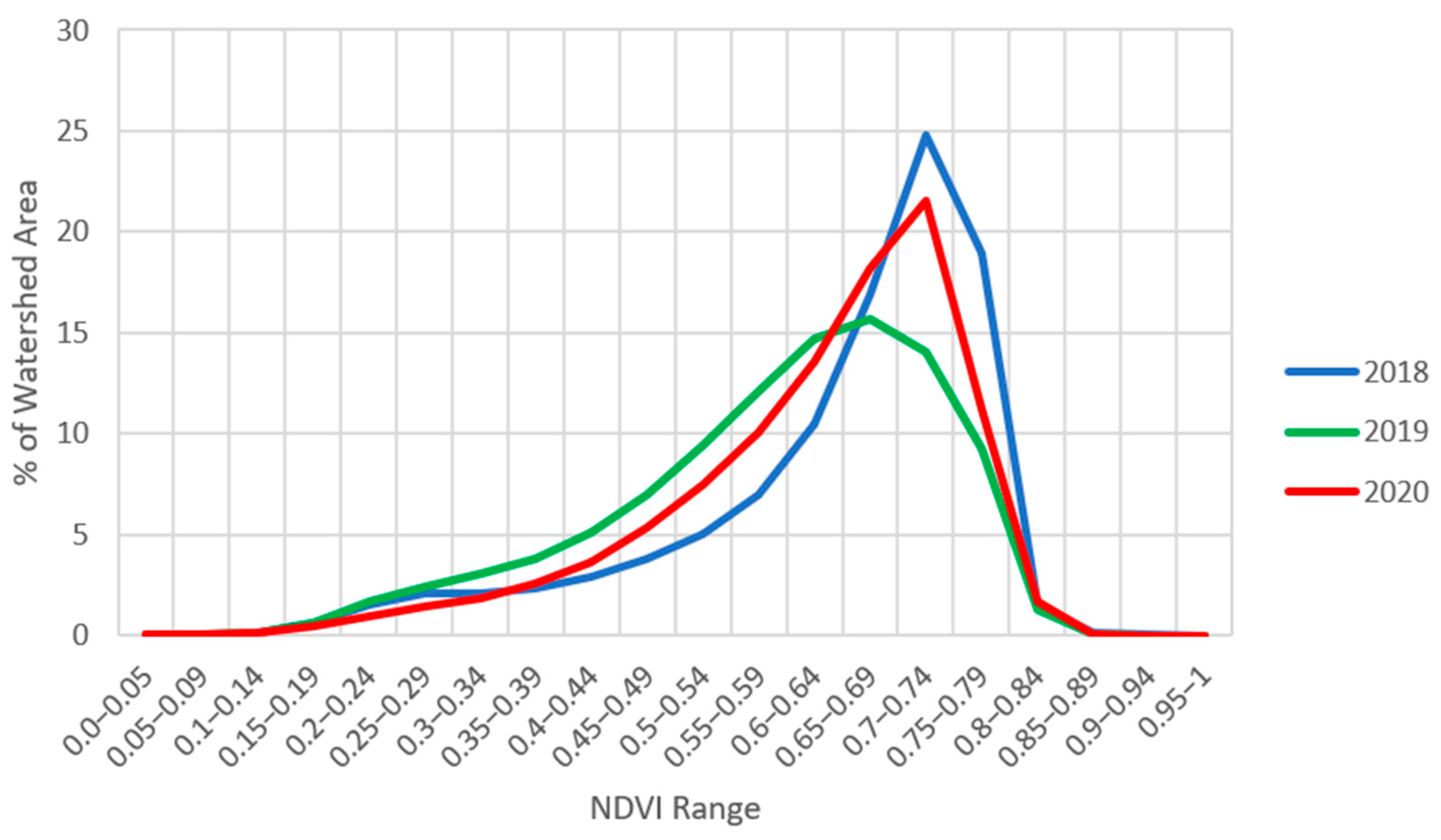
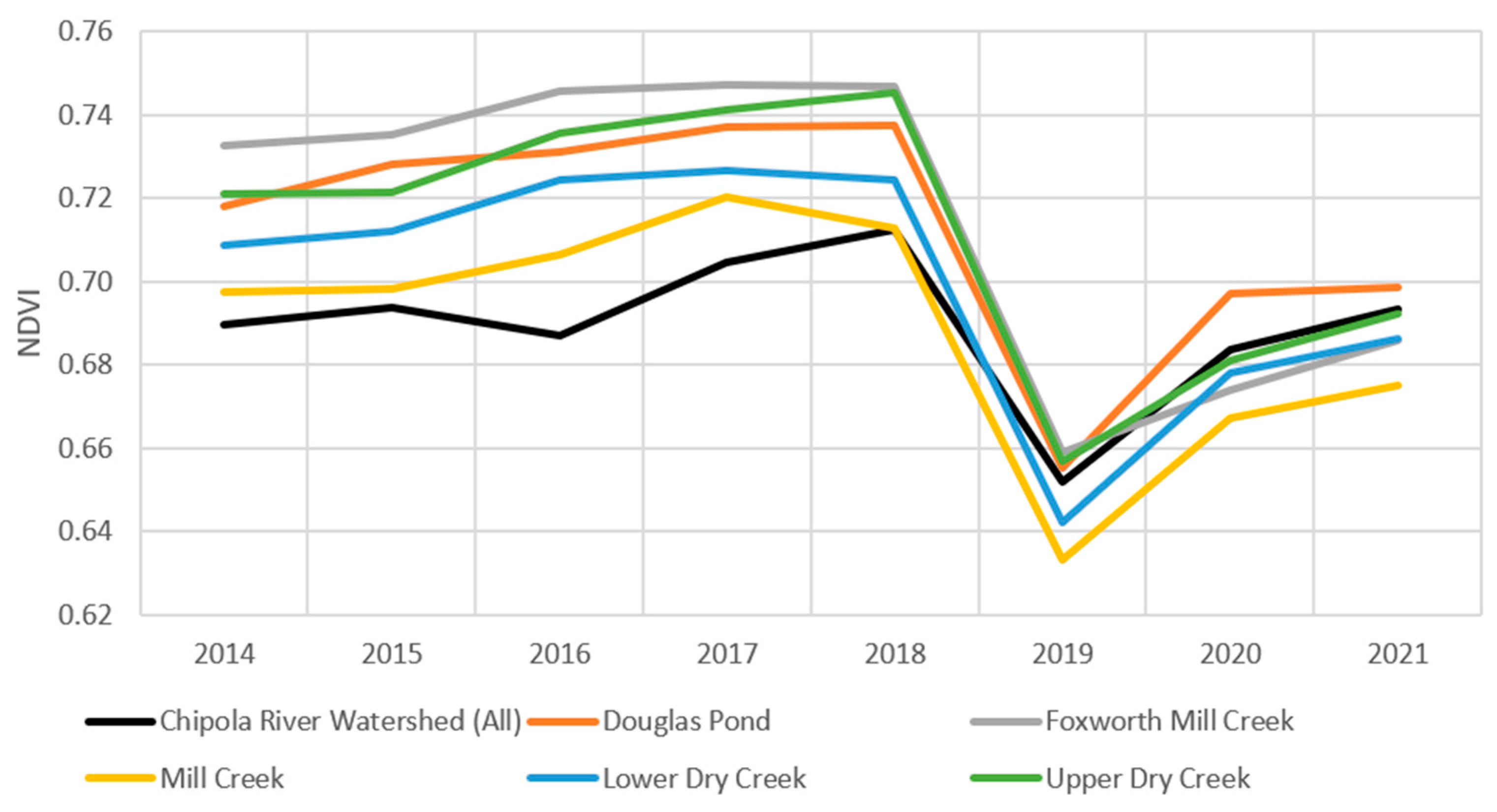

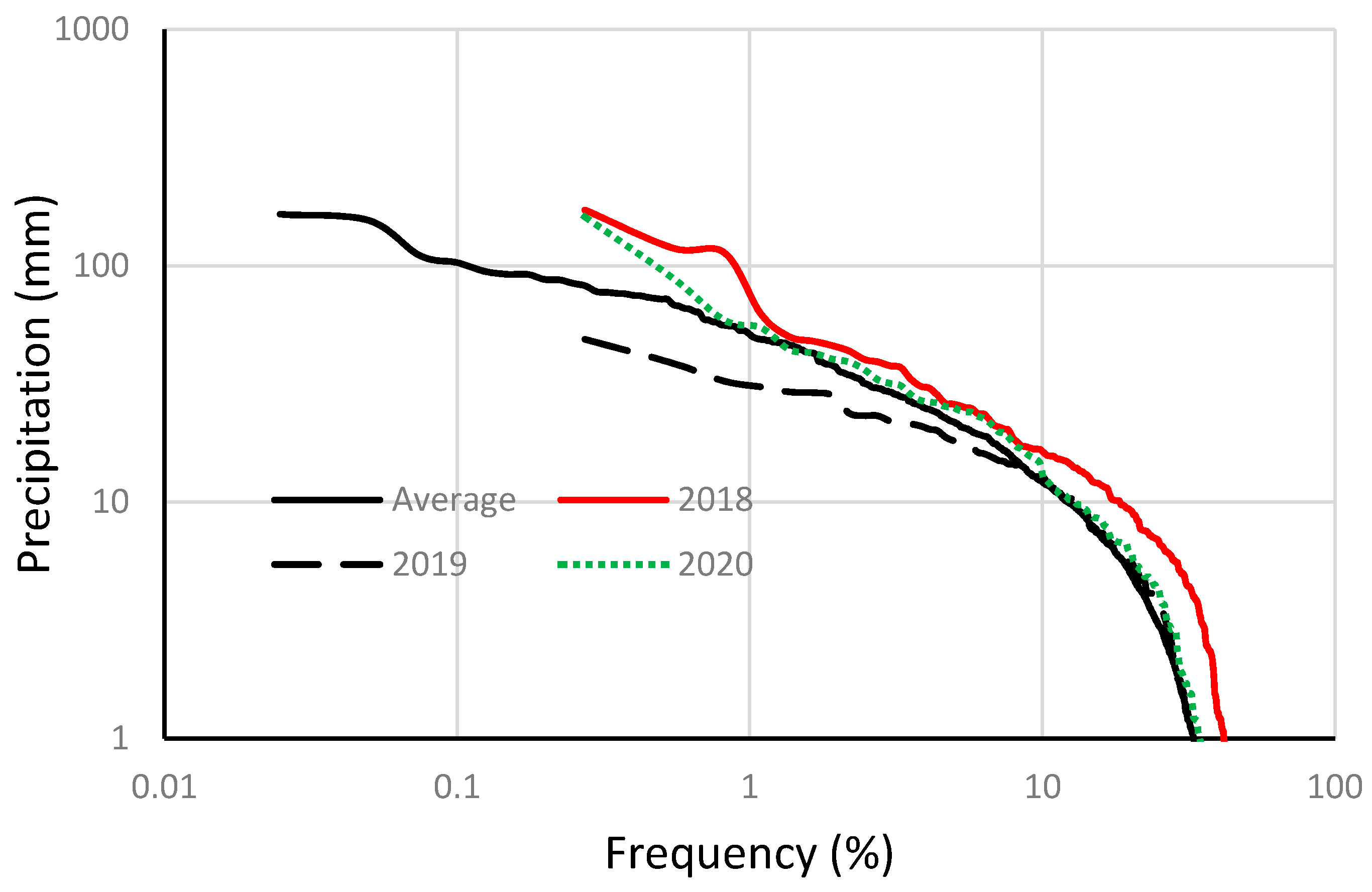
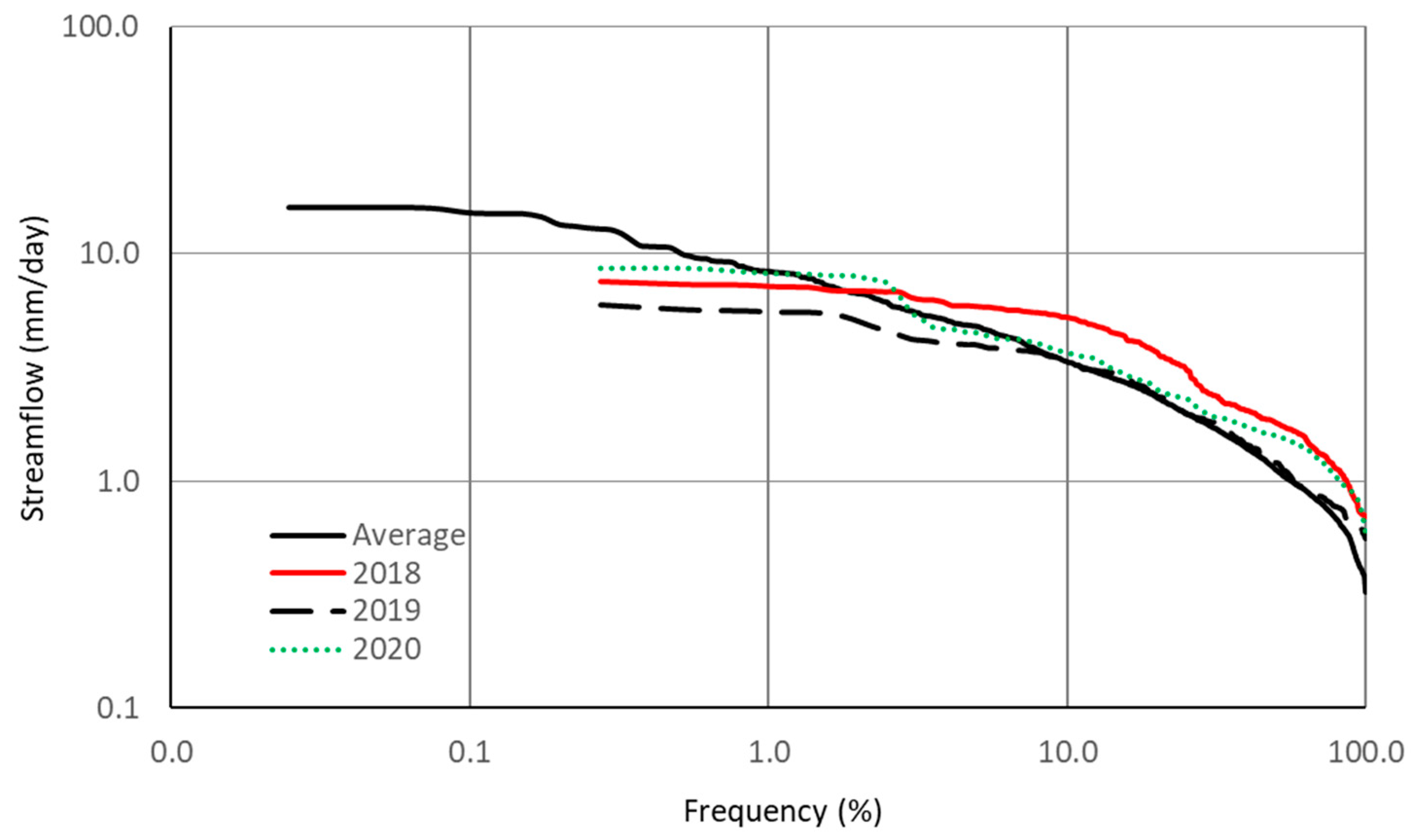
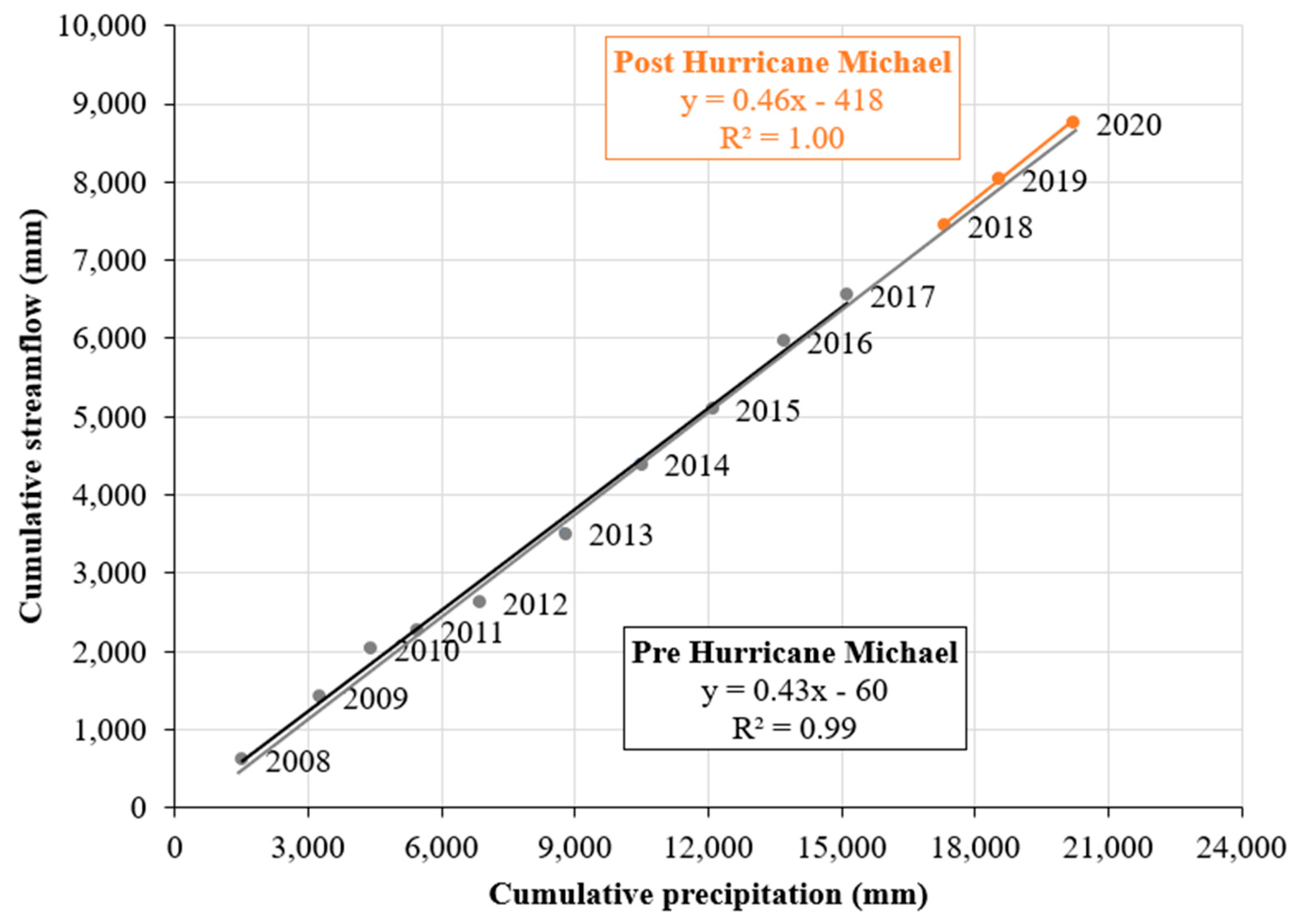
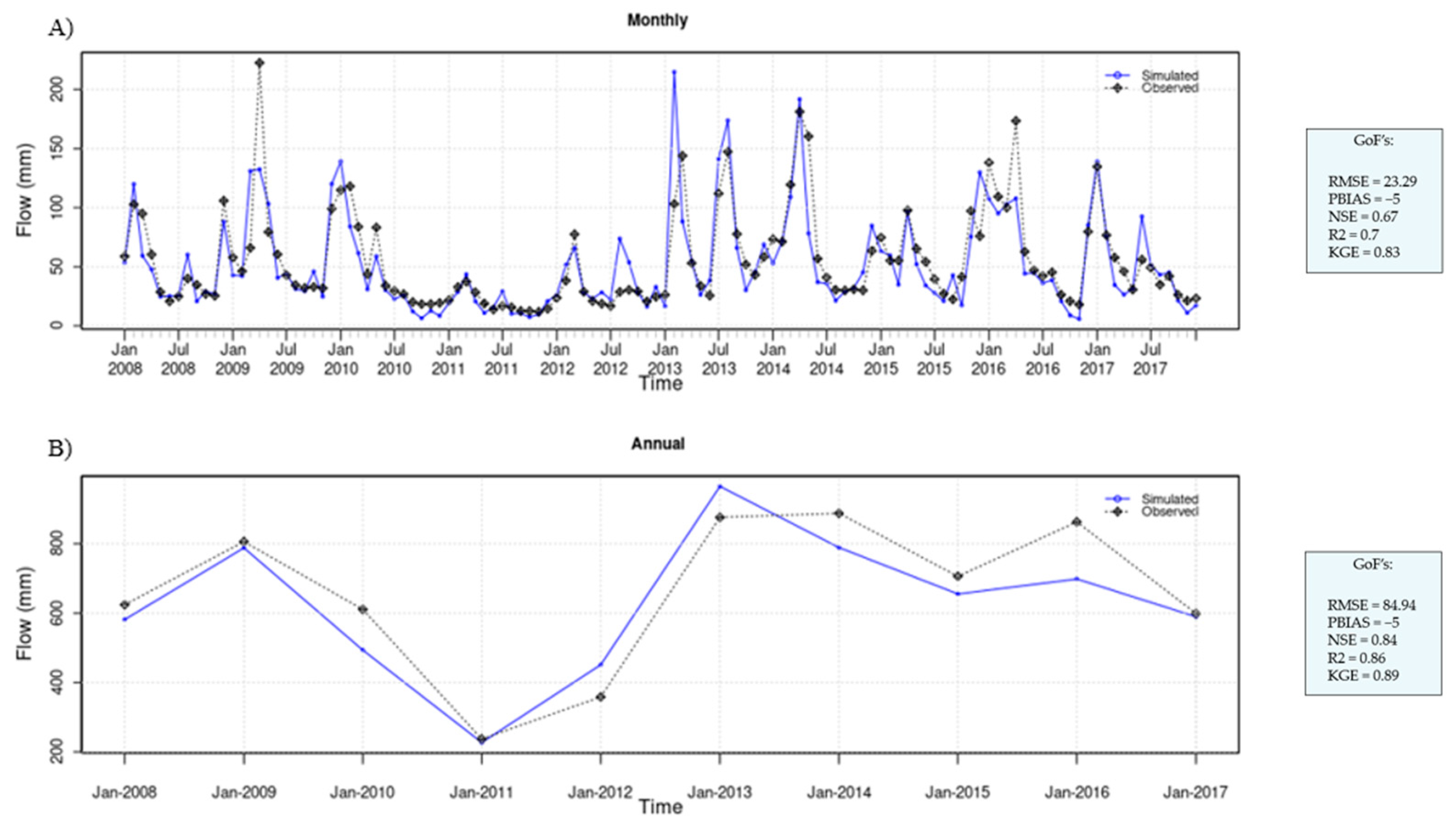
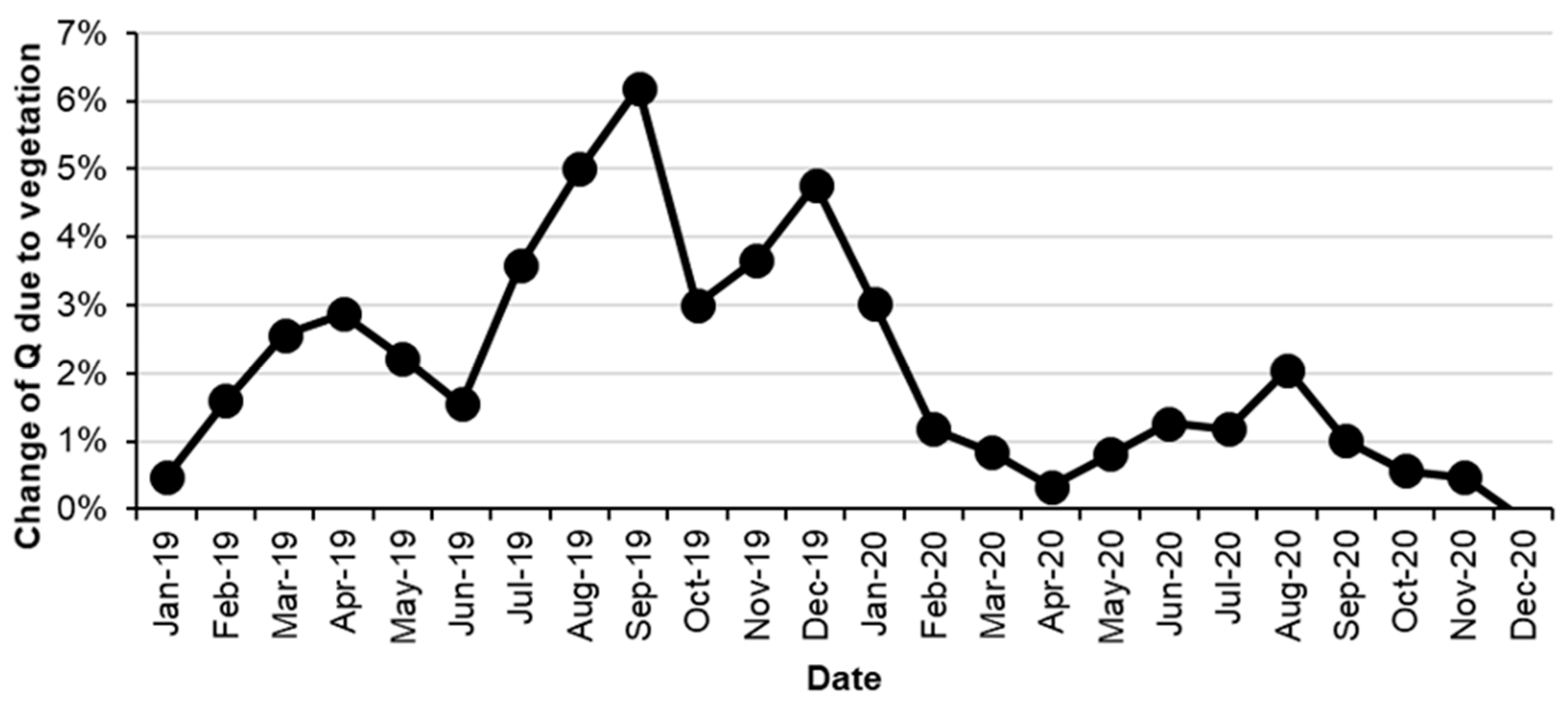

Publisher’s Note: MDPI stays neutral with regard to jurisdictional claims in published maps and institutional affiliations. |
© 2022 by the authors. Licensee MDPI, Basel, Switzerland. This article is an open access article distributed under the terms and conditions of the Creative Commons Attribution (CC BY) license (https://creativecommons.org/licenses/by/4.0/).
Share and Cite
Worley, E.; Liu, N.; Sun, G.; Norman, S.P.; Christie, W.M.; Gavazzi, M.; Boggs, J.; McNulty, S.G. Impacts of Hurricane Michael on Watershed Hydrology: A Case Study in the Southeastern United States. Forests 2022, 13, 904. https://doi.org/10.3390/f13060904
Worley E, Liu N, Sun G, Norman SP, Christie WM, Gavazzi M, Boggs J, McNulty SG. Impacts of Hurricane Michael on Watershed Hydrology: A Case Study in the Southeastern United States. Forests. 2022; 13(6):904. https://doi.org/10.3390/f13060904
Chicago/Turabian StyleWorley, Elijah, Ning Liu, Ge Sun, Steven P. Norman, William M. Christie, Michael Gavazzi, Johnny Boggs, and Steven G. McNulty. 2022. "Impacts of Hurricane Michael on Watershed Hydrology: A Case Study in the Southeastern United States" Forests 13, no. 6: 904. https://doi.org/10.3390/f13060904
APA StyleWorley, E., Liu, N., Sun, G., Norman, S. P., Christie, W. M., Gavazzi, M., Boggs, J., & McNulty, S. G. (2022). Impacts of Hurricane Michael on Watershed Hydrology: A Case Study in the Southeastern United States. Forests, 13(6), 904. https://doi.org/10.3390/f13060904









